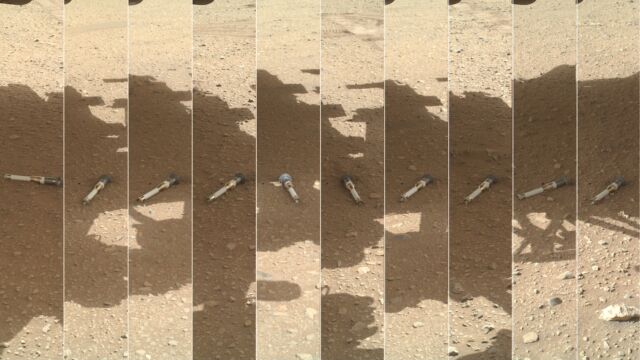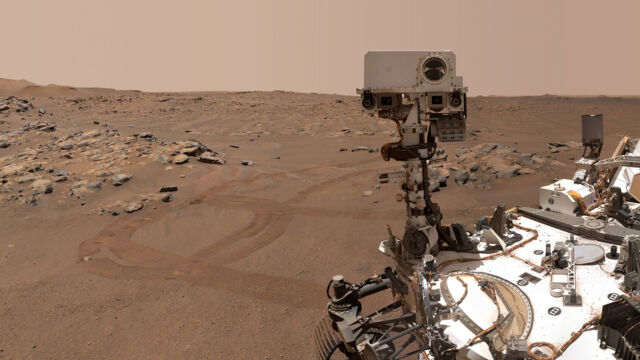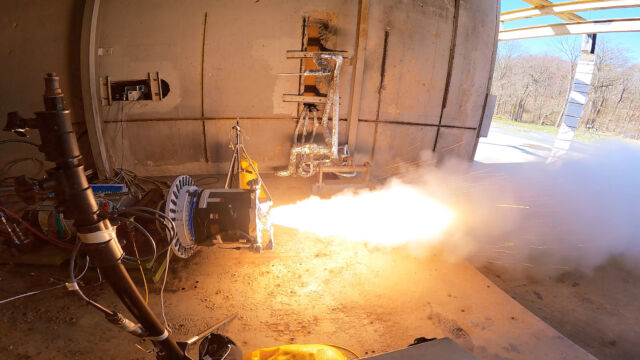
NASA's $11 billion plan to robotically bring rock samples from Mars back to Earth is too expensive and will take too long, the agency's administrator said Monday, so officials are tasking government and private sector engineers to come up with a better plan.
The agency's decision on how to move forward with the Mars Sample Return (MSR) program follows an independent review last year that found ballooning costs and delays threatened the mission's viability. The effort would likely cost NASA between $8 billion and $11 billion, and the launch would be delayed at least two years until 2030, with samples getting back to Earth a few years later, the review board concluded.
But that's not the whole story. Like all federal agencies, NASA faces new spending restrictions imposed by the Fiscal Responsibility Act, a bipartisan budget deal struck last year between the White House and congressional Republicans. With these new budget headwinds, NASA officials determined the agency's plan for Mars Sample Return would not get specimens from the red planet back to Earth until 2040.
One of the primary goals of NASA's Perseverance rover, driving around Mars since 2021, is to collect and catalog more than 30 samples of Martian rocket, sediment, and air for return to Earth by a future mission. Perseverance is sealing these specimens in cigar-size titanium tubes, and collectively, they will total roughly half a kilogram in mass.
Returning pristine specimens from Mars to Earth for analysis in ground-based labs has been a top priority for the planetary science community's decadal survey process. But getting those samples back has turned out to be a lot more challenging than NASA thought.
"The bottom line is that $11 billion is too expensive, and not returning samples until 2040 is unacceptably too long," NASA Administrator Bill Nelson told reporters Monday.
AdvertisementGetting in gear
So NASA is shaking up the Mars Sample Return program. The preexisting plan came together over the last seven years, with refinements from engineers at NASA's Jet Propulsion Laboratory, the institution charged with managing the effort.
The most recent iteration of the Mars Sample Return mission involves two launches. One would take place in 2030 with a European spacecraft that will orbit Mars and wait for the second mission—the responsibility of NASA—to depart Earth in 2035 with a Sample Retrieval Lander (SRL). The second launch would involve a Mars Ascent Vehicle (MAV), the rocket necessary to launch samples off the red planet and into space.
The lander would deliver the MAV to the Martian surface, and the Perseverance rover, already on Mars, will deliver sealed tubes of rock and soil specimens into a container for the trip back to Earth. The MAV would then launch the material into orbit around Mars, where the European-built Earth Return Orbiter would rendezvous with the sample container and pick it up for the journey home.
These launches were previously scheduled to occur two years apart in the late 2020s, but those target dates are no longer attainable with the current plan and budget, officials said Monday. Stretching out the two launches over a five-year span will spread out expenditures on the MSR program to fit within the agency's projected budget without "cannibalizing" NASA's other planetary science projects, like the Dragonfly mission to explore Saturn's moon Titan.
The most recent plan unveiled Monday would also remove two helicopters from the Sample Retrieval Lander. These helicopters, which could have picked up sample tubes and delivered them to the pod that would return them to Earth, were supposed to be based on NASA's Ingenuity helicopter successfully demonstrated on Mars with the Perseverance rover. Instead, the updated plan would rely entirely on Perseverance to hand off sample tubes to the Mars Ascent Vehicle.
There are also a few other changes to NASA's MSR architecture, including replacing solar arrays on the Sample Retrieval Lander with a nuclear power generator. This would improve the lander's reliability and provide better thermal conditions for the MAV, according to Sandra Connelly, deputy head of NASA's science mission directorate.
However, this architecture is pretty much dead on arrival.

"The current budget environment doesn’t allow us to pursue an $11 billion architecture, and 2040 is too long," Nelson said. "So what to do? I have asked our folks to reach out with a request for information to industry, to JPL, and to all NASA centers and to report back this fall an alternate plan that would get it back quicker and cheaper."
NASA's goal, according to Nelson, is to try to stay within a $5 billion to $7 billion range for the total cost of the MSR program, in line with a broad cost outline from the National Academies' planetary science decadal survey.
“I’m expecting to get everybody in high gear, and that we have the answers to this by this fall," Nelson said.
Asking for help
As soon as Tuesday, NASA will release a solicitation for the private sector to propose ideas to bring back Perseverance's samples. Companies with the best ideas will receive some NASA funding later this year to support 90-day studies, and these reports will inform agency leaders on how to proceed with the Mars Sample Return. NASA could be ready to make decisions on a new architecture by the end of the year.
“We are opening up the aperture and allowing industry to propose concepts," said Nicky Fox, head of NASA's science mission directorate. "Yes, we would be OK with a higher risk posture. I'm definitely looking at things that have high heritage, the kind of tried and true architectures and elements of architectures that maybe have worked in the past, different ways of doing the various elements, a smaller Mars Ascent Vehicle.”
The MAV is one of the most delicate pieces of the Mars Sample Return architecture. NASA's concept involves a two-stage solid-fueled rocket, developed by Lockheed Martin and Northrop Grumman, that would be delivered to the surface of Mars aboard the Sample Retrieval Lander, which is baselined to have more than twice the mass of NASA's Perseverance rover, currently the heaviest spacecraft to ever land on Mars.
AdvertisementDeveloping a lighter lander and a smaller rocket certainly wouldn't hurt, according to Doug McCuistion, former director of NASA’s Mars exploration program, who is now consulting the agency on the MSR program.
“Those are the drivers of mass and those are the drivers of cost and complexity, so it’s important to draw those down," he said.
At the same time as the industry studies, NASA leaders will ask engineers at JPL and other NASA centers for their own ideas. Fox said NASA hopes "out of the box" concepts will allow the agency to get the samples back to Earth in the 2030s. "This is definitely a very ambitious goal," she said. "We’re going to need to go after some very innovative new possibilities for a design, and certainly leave no stone unturned.”
There are several commercial companies that might have something to offer NASA.
Lockheed Martin is the only entity in the United States outside of NASA's Jet Propulsion Laboratory that has built a successful Mars lander. SpaceX's Starship rocket is designed to eventually land cargo and people on Mars. Theoretically, it could be used as a lander or an interplanetary transport for Mars Sample Return. NASA also has a roster of smaller US companies developing Moon landers that could be modified for landings on Mars.
Most likely, the architecture NASA ultimately chooses will mix and match various elements from industry, NASA centers, and the European Space Agency, which remains a committed partner on Mars Sample Return with the Earth Return Orbiter. Other options include returning the sample to the vicinity of the Moon, where a human mission or robotic spacecraft could pick up the Martian material for the final leg of the trip to Earth, according to Connelly.
"An industry partner, or centers, or JPL—this is totally arbitrary—they could propose using ERO (Earth Return Orbiter) and NASA’s MAV, but say, 'I’m going to create my own lander and my own CCRS (Capture, Containment, and Return System),'" Connelly said. "So there are different ways you can put these puzzle pieces together. They can create their own solution. There is no constraint on this."
Limits to Perseverance
Regardless of how this shakes out, Mars Sample Return will rival, and perhaps surpass, the James Webb Space Telescope as the most complex robotic space mission ever undertaken. The Sample Retrieval Lander will need to land more precisely on Mars than any prior mission in order to touch down near the Perseverance rover at Jezero Crater. Jezero was home to an ancient river delta and a lake the size of Lake Tahoe more than 3.5 billion years ago.
The robotic handoff from Perseverance to the sample container that will rocket back into space with the Mars Ascent Vehicle will also be a tricky effort. The launch of the MAV itself is also a first. No rocket has ever launched off of Mars and back into space. Then, at least under NASA's existing architecture, engineers must accomplish the first-ever rendezvous between two spacecraft in orbit around another planet. These are just a few of the challenges.
In response to a question from Ars, Fox said NASA does not envision actually requesting proposals for an end-to-end mission from industry or the science community. Instead, NASA will collect ideas from companies and NASA centers to inform changes to the government's overall design.
Then there's the question of what to do with the nuclear-powered Perseverance rover. Originally, Perseverance wasn't supposed to be part of the MSR architecture once it finished its job of collecting samples. NASA initially designed the follow-on mission to retrieve the samples with its own small rover to go out and pick up the sample tubes dropped on the ground by Perseverance. After axing the rover due to cost concerns, NASA added two helicopters to the retrieval mission. Now, officials have deleted those.
Advertisement
Perseverance is now critical for MSR. Under the updated MSR architecture, NASA would end Perseverance's mission of exploration in 2028 and drive the rover back to a parking spot in Jezero Crater to await landing of a retrieval spacecraft. At that time, Perseverance would "basically go into a quiescent mode until we can transfer the samples over for return to Earth," Connelly said.
NASA officials are optimistic Perseverance can survive long enough to do this job. The rover has ample power from its nuclear battery, and its sister rover, Curiosity, remains healthy on Mars nearly 12 years since landing.
Despite the setbacks, NASA continues to see Mars Sample Return as its top priority in planetary science. The agency is deferring preliminary work on the second-highest decadal priority, a robotic spacecraft to orbit Uranus, to move forward with MSR. China also plans to launch its own robotic mission to return samples from Mars around 2030.
“I think it’s fair to say that we are committed to retrieving the samples that are there, at least some of those samples," Nelson said.
Using sophisticated laboratories on Earth, scientists can learn more from Martian rock core samples and dust grains than they could with miniaturized labs carried aboard rovers operating in situ on the red planet. Researchers want to know whether life ever formed on Mars and what conditions on the planet were like billions of years ago.
“NASA does visionary science, and returning diverse, scientifically relevant samples from Mars is a key priority,” Fox said. "Our next steps will position us to bring this transformational mission forward and deliver revolutionary science from Mars—providing critical new insights into the origins and evolution of Mars, our solar system, and life on Earth.”
An L for JPL?
Until now, NASA's Mars Sample Return program has been managed by JPL, the lab in Southern California that runs most of the agency's deep space missions. JPL first took humanity into the Solar System with Voyager and explored Jupiter and Saturn with Galileo and Cassini. All of NASA's past Mars landing missions were managed by JPL.
But the legendary research lab, run by Caltech under contract from NASA, is in crisis. Apart from MSR's rising costs and delays, independent reviewers blamed JPL mismanagement for NASA's Psyche asteroid mission missing its 2022 launch window, a delay that cost taxpayers about $250 million.
Last year, NASA reduced spending on Mars Sample Return when deciding how to move forward with the program, prompting JPL to lay off 100 contractors. The workforce impacts escalated in February, when JPL said it would lay off about 530 employees, plus 40 additional contractors, or roughly 8 percent of its staff.

Fox said NASA will provide $310 million for the Mars Sample Return program in fiscal year 2024, which runs through September 30. This is less than one-third of the White House's original fiscal year 2024 budget request of $949 million. NASA said the White House's request for next year is $200 million. This money will pay for industry studies and will maintain some technology development efforts in areas likely to be utilized in the ultimate MSR architecture.
AdvertisementHow much of that reduced funding will actually go to JPL? And will JPL need another round of layoffs? It's too early to say, Fox said. NASA is reshaping management of the entire Mars Sample Return program and elevating individual pieces of the architecture managed at different NASA centers, "instead of everything being under JPL," she said.
On top of the budget cuts, the agency's decision to cast a wide net for ideas on how to do Mars Sample Return is another hit for JPL, which could lose its decades-long grip on NASA's Mars program. Nelson issued a call for the lab to rise to the occasion.
"Right now, if JPL were to come up with the answer, then I’d say JPL is going to be sitting pretty good," he said. "But we’re opening this up to everyone because we want to get every new and fresh idea that we can.”



















